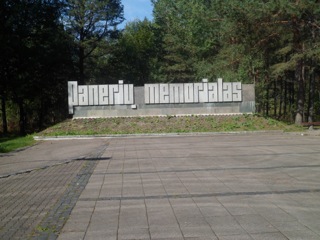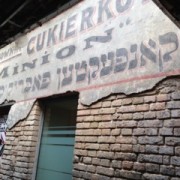Ponary Forest Massacre
By: Jake “Andy” Fabrizio
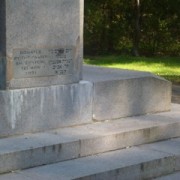 Imagine the shock and outrage if a cohort of eleven students was ruthlessly slaughtered as the result of a sick ideological platform. The public would not be silenced. Now imagine this happening about two hundred thirty six times over to similarly innocent people with no one to stop it. There you have a day at the Ponary Forest during the liquidation of the Vilna ghetto by the Nazis. Two thousand six hundred innocent people were shot and flung into a pit in a single day alone. All evidence was later burned.
Imagine the shock and outrage if a cohort of eleven students was ruthlessly slaughtered as the result of a sick ideological platform. The public would not be silenced. Now imagine this happening about two hundred thirty six times over to similarly innocent people with no one to stop it. There you have a day at the Ponary Forest during the liquidation of the Vilna ghetto by the Nazis. Two thousand six hundred innocent people were shot and flung into a pit in a single day alone. All evidence was later burned.
Growing up, I had always been taught that the Holocaust was the systematic murdering of six million Jews, taking place mainly in concentration camps. Aside from the historical inaccuracy of where the mass murders took place, this enormous number had always posed difficulties for my comprehension. I understood that it was the truth, however I could not tangibly grasp the magnamity of the situation. Six million is such a large number; he concept of killing that many people in just a matter of years is unbelievable, even abstract. Learning that one hundred thousand people were executed altogether in the Ponary Forest helped me put the Holocaust into better perspective, but even that horrific statistic was virtually uncountable in a normal capacity. Soon after relating this fact, our tour guide mentioned that on one fateful day, in the Forest, those nearly three thousand souls perished. My heart dropped. This number was real. It is slightly over the number of students in my high school; it is about twenty percent of the student body at Syracuse University. As strange as it is to put the Holocaust in such a context, this is how the atrocities that composed the Holocaust finally made sense to me. Twenty six hundred people gone. And that was just one day- one location- in the midst of four years of horror.
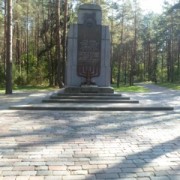 Earlier in the day, our bus had pulled into an empty parking lot with a large stone sign denoting that we had arrived at the memorial site of the Ponary Forest Massacre. The sign was large and could not be missed from the parking lot, but it left me wondering how effective this form of advertisement was, considering we had driven through the woods for at least ten minutes before arriving at the lot. Prior to this, there was not a single sign or arrow pointing towards the forsaken site of memory. Without prior knowledge and planning, I do not see how anyone would even know that such a place existed. Only those who dive deep into studies of the Nazi occupation will know of the Forest’s existence. Much education concerning the Holocaust is shrouded in inaccuracy or, at the very least, has many omissions. The fact that it is but twenty minutes outside of the capital city of Lithuania- Vilnius- is even more perturbing. The site was not included in our “Vilnius in Three Days” pamphlet, which boasted famous historical and tourist sites. The pamphlet is produced with municipal funds.
Earlier in the day, our bus had pulled into an empty parking lot with a large stone sign denoting that we had arrived at the memorial site of the Ponary Forest Massacre. The sign was large and could not be missed from the parking lot, but it left me wondering how effective this form of advertisement was, considering we had driven through the woods for at least ten minutes before arriving at the lot. Prior to this, there was not a single sign or arrow pointing towards the forsaken site of memory. Without prior knowledge and planning, I do not see how anyone would even know that such a place existed. Only those who dive deep into studies of the Nazi occupation will know of the Forest’s existence. Much education concerning the Holocaust is shrouded in inaccuracy or, at the very least, has many omissions. The fact that it is but twenty minutes outside of the capital city of Lithuania- Vilnius- is even more perturbing. The site was not included in our “Vilnius in Three Days” pamphlet, which boasted famous historical and tourist sites. The pamphlet is produced with municipal funds.
Negligence of the memory of Lithuanian Jews was a recurring theme during our three-day stay in Vilnius, and it certainly culminated in the Ponary Forest. This negligence is manifest in the central monument at Ponary. A striking monument to the Jewish victims, who comprised seventy percent of those murdered, stands tall in the middle of the forest. A tiny inscription on the side of the monument was brought to our attention. A Jewish family had donated the monument. The Jewish population vanished in both physicality and memory. There is little thought in the Lithuanian social conscious about the seventy thousand Jews that were murdered. Some Lithuanians even took part in the executions. Anti-Semitism was rampant, and the country is still struggling to come to terms with their turbulent past. It seems as though the state would rather ignore history than reconcile. There were no other visitors during our tour. Ethnic Lithuanians are only the fourth most popular group to visit, despite the proximity to their capital. The director also told us that schools and student groups rarely visit as it is not required for them to know. In fact, our guide said that most Lithuanians either knew nothing of the history or were overtly opposed to visiting the monument and paying respect to the truth. There is no collective mourning at Ponary.
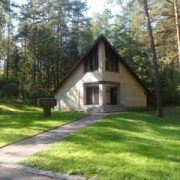 The entire memorial site was ill marked. Without the help of our passionate tour guide and our extensive background knowledge, we would have learned next to nothing about the massacre itself. Sadly, this is in no way an exaggeration. Monuments are placed haphazardly around the site, and there is no uniformity amongst them. Many do not even have a path leading up to them. There is a small building on the premises that serves as an informational museum. The museum provides some background information of the massacre, but it is mostly anecdotal stories, which, while extremely important to the memory of those murdered, seem out of place without supplemental knowledge. Several times our tour guide interjected our reading to point out an error in the facts provided. The museum did not seem to coincide with memorial site itself in purpose and evocation of feelings. There is a clear disconnect between the museum and the monuments; both offer bits and pieces of history, but the whole story- the brutal, factual truth in its entirety- is nowhere to be found. The message is unclear.
The entire memorial site was ill marked. Without the help of our passionate tour guide and our extensive background knowledge, we would have learned next to nothing about the massacre itself. Sadly, this is in no way an exaggeration. Monuments are placed haphazardly around the site, and there is no uniformity amongst them. Many do not even have a path leading up to them. There is a small building on the premises that serves as an informational museum. The museum provides some background information of the massacre, but it is mostly anecdotal stories, which, while extremely important to the memory of those murdered, seem out of place without supplemental knowledge. Several times our tour guide interjected our reading to point out an error in the facts provided. The museum did not seem to coincide with memorial site itself in purpose and evocation of feelings. There is a clear disconnect between the museum and the monuments; both offer bits and pieces of history, but the whole story- the brutal, factual truth in its entirety- is nowhere to be found. The message is unclear.
The story, however, is not lost, and a handful of dedicated individuals are working to make sure that it never will be. There is hope for the future of the Ponary Forest Memorial. A contest is underway to design a new memorial site and museum in an attempt to bring uniformity to the site of memory. This renovation is important for the recognition of all victims, but it is crucial to the preservation of the memory of Jewish Lithuania, a forgotten people. This project, which is at least partially funded by the state, will work to increase both tourism and educational pursuits. The project manager hopes to reach out to the schools and educate Lithuanian youth. If the project is completed successfully, Ponary will finally have a chance to settle into the collective memory of Lithuanians, and the country will be able to move forward. The new museum will offer a forum for both education and reflection. Those lives that were lost will not be forgotten.

